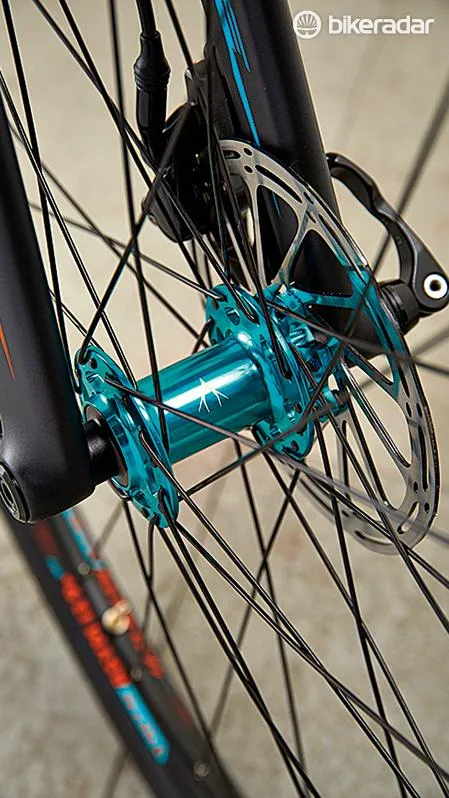Whyte’s UK designers have a reputation for pushing past accepted mountain bike-handling standards – and it’s obvious straight away that the Saxon Cross isn’t following conventional handling wisdom when it comes to drop-barred bikes.
Slack-angled and stable
Following the lead of its mountain bikes, Whyte has used a slacker head angle and a longer front end than normal to create a more pronounced self-correcting character to the steering. This immediately adds straight-line stability, which is great for confidence at higher speeds and/or on rougher terrain.
That same stability does mean you might have to recalibrate your steering reactions at first. Otherwise it’s easy to get drawn into the Whyte’s confidence and end up entering corners faster than you expect, then doubting your own bravery and sailing past the apex points and running wide.

There's great colour coordination on the Saxon Cross
However, should you use the short stem to push the bar more aggressively into turns you’ll find the Whyte fully committed and whipping around so fast it might startle you in completely the opposite way.
Even when you’ve fully adjusted to the Whyte’s naturally more confident and cocksure handling, you still have to give the rubber due respect – because it’s dealing with higher traction demands than normal. Thankfully the WTB Cross Boss tyres have a relatively soft compound and come tubeless as standard, maximising the supple rubber’s connection to the surface and reducing the chances of punctures.
The shortish 80mm stem and the accuracy of the 15mm thru-axled fork also help to manage cornering lines and tyre loading so you can take the tyres right to the edge of sliding and still get them back before your hip hits the deck.
Versatile spec deck
The Whyte Cross is well kitted out for versatility, with Crud Catcher fittings under the down tube, and mounts for mudguards and even a ‘dropper-post’ mount (droppable seatposts are common on mountain bikes).

The 160mm rotors give the Rival brakes extra poke to control faster off-road riding and road descents
But the threaded dropout receiver can fall out and roll into hiding when you remove the thru-axle, the internally routed gear cables enter the frame at right angles and can knock your knees, and the rear gear cable leaves the frame early and unceremoniously to bypass the ‘hidden’ seatpost clamp that’s buried in the top-tube. Most irritatingly, the clamp’s contracting wedges wouldn’t tighten enough to stop the post and saddle twisting and gradually slipping down.
On the bright side, the chubby tubeless tyres combine with large, elegantly curved rear dropouts to give a pleasantly forgiving ride for an alloy bike. The 38-tooth chainring and 11-42 tooth Shimano XT cassette give ratios that will get you up the steepest inclines (with a lower bottom gear than a compact crankset/standard cassette combo) to fully exploit the tyres’ grip.
Even without a carbon frame and oversized bottom bracket, the Whyte doesn’t lack a purposeful feel. And once you get used to the handling and the speed that it encourages you to reach, the 160mm rotors give the SRAM Rival brakes extra poke to control faster off-road riding and road descents. That said, its 10kg weight does require more muscle power to get you up the hills in the first place.




